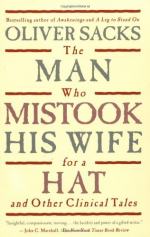
|
| Name: _________________________ | Period: ___________________ |
This test consists of 15 multiple choice questions and 5 short answer questions.
Multiple Choice Questions
1. What surgery is the main character admitted into the hospital to have?
(a) Gallbladder surgery
(b) Appendectomy
(c) Back surgery
(d) Kidney transplant
2. How does the patient respond to Sacks?
(a) He believes Sacks hesitantly.
(b) He argues with Sacks but eventually agrees with him.
(c) He recognizes that Sacks is right.
(d) He does not believe Sacks.
3. The main character suffers a stroke and this affects which side of his/her brain?
(a) Neither
(b) The Left
(c) The Right
(d) Both
4. Who is the main character of the chapter?
(a) Mr. P.
(b) Christina
(c) Jimmie G.
(d) Madeline J.
5. How long does Sacks cover the patient's condition without seeing recovery?
(a) One year
(b) Ten years
(c) Eight years
(d) Twenty years
6. What is his problem with body?
(a) He believes that his leg is someone else's.
(b) He believes that his arm is someone else's.
(c) He believes that his hands are someone else's.
(d) He believes that his face is someone else's.
7. Where does Sacks work at the time of this chapter?
(a) National Institutes of Mental Health
(b) Home for the Aged
(c) Therapist's Office
(d) Neuroscience Clinic
8. What additional form of memory can people with Jimmie G.'s disorder lose?
(a) Auditory Memory
(b) Olfactory Memory
(c) Sensual Memory
(d) Visual Memory
9. Which faculty of mind does Sacks argue is left out of psychology and neuroscience?
(a) Soul
(b) Spirit
(c) Emotion
(d) Judgment
10. What is a visual phantom?
(a) When a patient's perception is confused and they cannot navigate well.
(b) When a patient has a persistent hallucination of a person or other being accompanying or harassing him/her.
(c) When a patient has hallucinations of past events.
(d) When a patient sees shapes and colors that are not there.
11. Dr. P possesses which personal qualities.
(a) He is upbeat and intelligent.
(b) He is utterly detached from the world.
(c) He is angry but intelligent.
(d) He is cold and indifferent.
12. How does the remedy work?
(a) It helps him/her go the bathroom properly
(b) It increases the amount of food he/she eats
(c) It helps him/her to be independent
(d) It helps him/her with personal hygiene
13. What does Sacks call his chapters?
(a) Stories
(b) Chapters
(c) Studies
(d) Sections
14. How does Dr. Sacks respond to the main character?
(a) Informs him that his arm is his own.
(b) Informs him that his hands are his own.
(c) Informs him that his face is his own.
(d) Informs him that his leg is his own.
15. Which part of the main character's body does he/she refer to as "lumps of dough?"
(a) Feet
(b) Breasts
(c) Buttocks
(d) Hands
Short Answer Questions
1. What is the technical term of Jimmie G.'s disorder?
2. What is the main character's most frustrating disability?
3. Why might the disorder mentioned in the chapter be a good thing?
4. How many children does the main character have?
5. The main character's symptoms are:
|
This section contains 517 words (approx. 2 pages at 300 words per page) |

|




